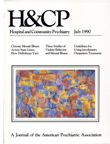Can Prediction of Violence Among Psychiatric Inpatients Be Improved?
Abstract
In an effort to improve the prediction of violence among psychiatric inpatients, the authors retrospectively studied 25 patients who were violent and 34 who were not violent after admission to a psychiatric emergency ward in Norway. The only demographic variable that discriminated between the two groups was violence in the family of origin; the violent group had experienced significantly more. The best single predictor of violence was a history of previous violence by the patient, which correctly classified 80 percent of the patients. The combined information about patients' level of aggression rated at referral and level of anxiety rated at admission correctly classified 78 percent. In a subgrouping of violent patients who inflicted injuries and did not inflict injuries, a higher percentage of the injury-inflicting patients were found to have a diagnosis of schizophrenia. These patients also had a higher level of aggression at referral.
Access content
To read the fulltext, please use one of the options below to sign in or purchase access.- Personal login
- Institutional Login
- Sign in via OpenAthens
- Register for access
-
Please login/register if you wish to pair your device and check access availability.
Not a subscriber?
PsychiatryOnline subscription options offer access to the DSM-5 library, books, journals, CME, and patient resources. This all-in-one virtual library provides psychiatrists and mental health professionals with key resources for diagnosis, treatment, research, and professional development.
Need more help? PsychiatryOnline Customer Service may be reached by emailing [email protected] or by calling 800-368-5777 (in the U.S.) or 703-907-7322 (outside the U.S.).



